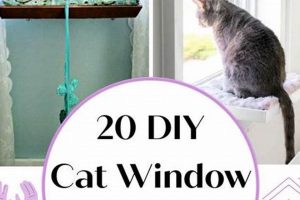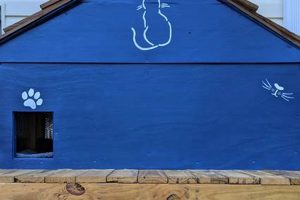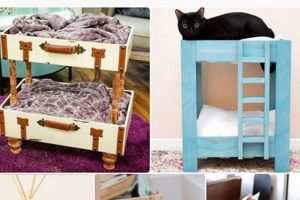A self-constructed housing for a cat’s toilet area, typically designed to conceal the litter box and minimize the spread of litter, can take many forms. For instance, repurposed furniture, modified cabinets, or custom-built structures often serve this purpose, reflecting the owner’s aesthetic preferences and spatial limitations.
Creating these personalized spaces offers several advantages. They contribute to improved home aesthetics by concealing an otherwise unappealing item. Furthermore, they can reduce odor and litter tracking, contributing to a cleaner and more hygienic environment. Historically, individuals have sought ways to integrate pet necessities seamlessly into their living spaces, and this reflects a modern extension of that desire.
The subsequent sections will explore design considerations, material selection, and construction techniques involved in realizing these functional and visually appealing additions to a home.
Construction Tips for a Concealed Cat Waste Station
The following suggestions aim to provide practical guidance for constructing a discreet and functional housing solution for a cat’s litter box.
Tip 1: Material Selection: Prioritize durable and easily cleanable materials. Moisture-resistant wood, laminate, or plastic are viable options. Consider the potential for scratches and select a finish that can withstand feline interaction.
Tip 2: Ventilation is Crucial: Incorporate adequate ventilation to minimize odor buildup. Vents, strategically placed openings, or a small fan can enhance airflow. Ensure vents are designed to prevent litter from escaping.
Tip 3: Access for Cleaning: Design the structure with easy access for routine cleaning and litter replacement. A hinged top, sliding door, or removable panel will simplify maintenance tasks.
Tip 4: Size and Dimensions: Account for the cat’s size and behavior when determining dimensions. The enclosure should be large enough for the cat to comfortably turn around and dig. Consider the size of the litter box itself.
Tip 5: Secure Construction: Ensure the structure is stable and secure. Cats may jump on or attempt to climb the enclosure. Use sturdy fasteners and reinforce joints to prevent collapse or damage.
Tip 6: Entrance Design: The entrance should be appropriately sized and positioned for easy access while discouraging the scattering of litter. Consider a covered entrance or a raised lip to contain litter.
Careful planning and execution of these tips will result in a functional and aesthetically pleasing addition to the home.
The subsequent section provides concluding remarks and reinforces the value of these considerations.
1. Concealment
The primary function of a self-constructed cat waste station is, fundamentally, concealment. The litter box, an item often deemed visually unappealing, is hidden from plain sight within a structure designed to blend into the surrounding environment. This serves to minimize the impact of a functional object on the aesthetic of a living space. The effect of successful concealment is a more visually harmonious interior design, where the presence of a pet necessity does not detract from the overall ambiance. Examples range from modified cabinets that appear as standard furniture to custom-built units integrated into existing shelving systems. The practical significance lies in transforming an area devoted to pet hygiene into a more attractive and integrated part of the home.
The level of concealment can vary widely, influencing both the complexity of the build and the degree of aesthetic improvement. Some enclosures offer only partial concealment, with a simple screen or partial covering to obscure the litter box. Others provide complete concealment, with an elaborate facade designed to mimic a different type of furniture. The choice depends on the owner’s priorities: budget, skill level, and desired aesthetic outcome. However, it is vital to note that concealment must never compromise the cat’s accessibility to the litter box. The aim is to improve the human experience without negatively affecting the animal’s needs.
Concealment, therefore, stands as a key design driver when considering a do-it-yourself project of this nature. Understanding its role and prioritizing it effectively during the planning and construction stages will result in a functional and aesthetically pleasing addition to the home, satisfying both the needs of the pet and the design sensibilities of the owner. The primary challenge lies in balancing aesthetic considerations with the practical requirements of accessibility, ventilation, and ease of maintenance.
2. Odor Control
Effective odor control is paramount in the design and construction of a self-assembled cat waste station. The primary objective is to minimize the emission of unpleasant smells associated with feline waste, thereby maintaining a more agreeable domestic environment. The presence of such odors can lead to discomfort for occupants and potentially compromise indoor air quality. Consequently, design features explicitly addressing odor mitigation are essential components of any successful project of this nature. Examples include strategically placed ventilation, use of odor-absorbing materials, and appropriate litter selection to mitigate unpleasant smells.
Ventilation plays a crucial role in preventing odor buildup. The design of a litter box enclosure should incorporate airflow to dissipate odors and reduce humidity. This can be achieved through the installation of vents, strategically positioned openings, or even the integration of a small, low-noise fan. Furthermore, the choice of construction materials can contribute to odor control. Materials with inherent odor-absorbing properties, such as activated carbon filters or specific types of wood, can help to neutralize unpleasant smells. The type of litter used within the enclosure significantly affects odor control. Clumping litter, silica gel litter, or other specialized litters are designed to minimize odor release and simplify waste removal, contributing to a cleaner overall environment.
In summary, odor control is not merely an ancillary feature of a homemade cat waste station; it is an integral design consideration that directly impacts the habitability and cleanliness of the home environment. Prioritizing effective ventilation, selecting odor-absorbing materials, and utilizing appropriate litter types are essential to achieving adequate odor control. The challenge lies in balancing these factors with other design considerations, such as aesthetics, accessibility, and cost-effectiveness, to create a functional and aesthetically pleasing addition to the living space. Ignoring this aspect leads to potential compromise to indoor environmental quality.
3. Accessibility
Accessibility, in the context of a self-constructed cat waste station, refers to the ease with which both the cat and the owner can interact with the unit. For the cat, this entails straightforward and unobstructed entry and exit, ample internal space for movement, and a sense of security within the enclosure. For the owner, accessibility relates to simplifying the tasks of cleaning, litter replacement, and periodic maintenance. A failure to adequately address accessibility for either party can result in the cat refusing to use the litter box, increased cleaning difficulty, or premature degradation of the structure. For instance, a small entrance may deter a larger cat, while a complex or unremovable lid will significantly complicate routine litter box scooping.
Consider the practical implications: a design incorporating a hinged lid grants unobstructed access to the litter box, simplifying cleaning. Alternatively, a pull-out drawer mechanism allows for complete removal of the litter box, facilitating thorough cleaning and litter replacement. From the feline perspective, an entrance placed too high or requiring a significant jump may discourage usage, particularly for older cats or those with mobility issues. Internal dimensions insufficient for comfortable turning can also lead to avoidance. The effect of prioritizing accessibility is a more hygienic environment, a happier cat, and reduced effort for the owner. Ignoring accessibility often leads to compensatory behaviors, such as the cat eliminating outside the designated area.
In conclusion, accessibility is not a secondary consideration, but an integral aspect of the design. Balancing the aesthetic goals of concealment and integration with the practical needs of the cat and owner requires careful planning and execution. Overlooking this key design element can negate the benefits of a well-constructed enclosure, leading to operational inefficiencies and potential behavioral problems. Understanding and prioritizing accessibility, therefore, is crucial for the overall success of a DIY cat litter enclosure project.
4. Material safety
Material safety is a paramount consideration in the design and construction of a self-made cat waste station. The materials selected directly impact the health and well-being of the cat, as well as the overall safety of the home environment. Inappropriate material selection can lead to toxic exposure, injury, or structural instability.
- Toxicity of Construction Materials
Certain paints, adhesives, and wood treatments contain volatile organic compounds (VOCs) or heavy metals that can be harmful if ingested or inhaled. Cats are particularly susceptible due to their grooming habits. For instance, treated lumber containing chromated copper arsenate (CCA) should be avoided, and low-VOC or non-toxic finishes should be prioritized to prevent potential health risks. Ingestion of even small amounts of some finishes can cause serious illness.
- Structural Integrity and Sharp Edges
The chosen materials must provide adequate structural support to prevent collapse or instability, which could cause injury to the cat. Additionally, sharp edges, splinters, or protruding fasteners pose a physical hazard. For example, using thin, unreinforced plywood could lead to structural failure, while leaving exposed staples or nails can result in lacerations or puncture wounds. Safe construction practices, including sanding edges and countersinking fasteners, are necessary.
- Resistance to Cleaning and Sanitation
Materials used in the construction must be able to withstand frequent cleaning and disinfection without degrading or releasing harmful chemicals. Porous materials, such as untreated wood, can harbor bacteria and odors, and some cleaning agents can react with certain plastics or coatings, releasing toxic fumes. Selecting non-porous, easily sanitized materials like sealed wood or certain plastics is crucial for maintaining a hygienic environment.
- Allergen Considerations
Some cats may have allergies or sensitivities to certain materials, such as specific types of wood or synthetic fibers. Exposure to these allergens can cause skin irritation, respiratory problems, or other adverse reactions. For example, cedar shavings, while sometimes used for odor control, can trigger allergic reactions in susceptible cats. Selecting hypoallergenic materials and monitoring the cat for any signs of sensitivity is important for ensuring its well-being.
The multifaceted nature of material safety necessitates careful planning and selection when undertaking a project of this nature. A thorough understanding of material properties, potential hazards, and the cat’s individual sensitivities is essential to creating a safe and functional enclosure. Neglecting these considerations can lead to preventable health problems and compromise the overall well-being of the animal.
5. Spatial integration
Spatial integration, in the context of a do-it-yourself cat litter enclosure, refers to the seamless incorporation of the structure into the existing home environment. It goes beyond mere placement, encompassing considerations of style, scale, and function to ensure the enclosure harmonizes with its surroundings rather than appearing as an obtrusive addition.
- Aesthetic Harmony
Achieving aesthetic harmony requires aligning the design of the enclosure with the existing decor. This includes matching colors, materials, and architectural styles. For instance, a modern home might benefit from an enclosure constructed from sleek, minimalist materials, while a more traditional space could incorporate repurposed antique furniture. The aim is to create a visual continuity that minimizes the disruption of the enclosure’s presence.
- Functional Compatibility
Functional compatibility involves ensuring the enclosure does not impede the usability of the surrounding space. This includes considering pedestrian traffic flow, access to other furniture or fixtures, and the overall layout of the room. An enclosure placed in a high-traffic area, for example, could create congestion and inconvenience. Conversely, an enclosure integrated into an underutilized corner can maximize space efficiency.
- Scale and Proportion
The scale and proportion of the enclosure must be appropriate for the size of the room. An overly large enclosure can dominate a small space, while an excessively small one may appear insignificant or out of place. Careful consideration of dimensions is essential to maintaining visual balance and preventing the enclosure from overwhelming the room’s proportions.
- Contextual Integration
Contextual integration involves adapting the design of the enclosure to its specific location within the home. An enclosure placed in a living room, for instance, might prioritize aesthetic appeal, while one located in a laundry room might focus on functionality and ease of cleaning. This adaptive approach ensures the enclosure serves its purpose without compromising the overall harmony of the space.
By carefully considering these facets of spatial integration, individuals can create cat litter enclosures that are not only functional and hygienic but also aesthetically pleasing and seamlessly integrated into their homes. The success of a do-it-yourself project hinges on this holistic approach, ensuring the enclosure enhances rather than detracts from the overall living environment. Examples include enclosures disguised as side tables, incorporated into bookshelves, or seamlessly built into existing cabinetry, showcasing the diverse possibilities of spatial integration.
6. Ease of cleaning
The design and construction of a self-built cat waste containment structure must prioritize simplified cleaning processes. This consideration directly affects hygiene, odor control, and the overall maintenance of a sanitary home environment. The effect of neglecting this aspect manifests in increased labor, potential health hazards, and a higher likelihood of the cat rejecting the litter box. For example, an enclosure with difficult-to-reach corners or a non-removable top will significantly complicate the routine task of scooping and disinfecting the litter box, leading to a buildup of bacteria and unpleasant odors.
Practical applications of this understanding include incorporating features such as removable trays, hinged lids, or large access panels into the design. A removable tray allows for complete litter replacement and thorough cleaning of the enclosure’s base, preventing the accumulation of debris and odors. Hinged lids or access panels provide easy access for daily scooping and spot cleaning, minimizing the time and effort required for maintenance. The choice of materials also plays a crucial role. Non-porous surfaces like sealed wood or durable plastic are easier to wipe down and disinfect compared to porous materials like untreated wood, which can absorb odors and bacteria. Design that avoids tight corners and intricate details are also extremely beneficial.
In summary, prioritizing ease of cleaning is an essential design principle for do-it-yourself cat litter enclosures. Implementing design features that facilitate simple and effective cleaning processes contributes directly to a healthier environment for both the cat and the owner. Overlooking this consideration leads to increased maintenance burdens and potential hygiene-related problems. The challenge lies in integrating ease of cleaning without compromising other critical design elements, such as aesthetics, spatial integration, and material safety, ultimately creating a functional and hygienic addition to the home.
7. Structural Integrity
Structural integrity is a foundational element in the construction of a self-assembled cat waste containment unit. The unit’s ability to withstand static and dynamic loads, resist deformation, and maintain its overall form directly correlates to its safety, longevity, and functionality. A structurally deficient enclosure poses a risk of collapse, leading to potential injury for the cat, damage to surrounding property, and a complete failure of its intended purpose. For example, an enclosure constructed with insufficient support or using inadequately joined materials could buckle under the cat’s weight or from accidental impact, negating the benefits of concealment and containment.
The selection of materials and the implementation of appropriate construction techniques are pivotal in ensuring structural robustness. High-density wood composites, reinforced plastics, or properly treated solid wood represent viable options. Fasteners, such as screws and bolts, should be appropriately sized and spaced to distribute stress effectively. The use of adhesives designed for load-bearing applications further strengthens joints. Furthermore, design considerations, such as incorporating internal supports, reinforcing corners, and minimizing unsupported spans, contribute to the overall stability of the enclosure. Ignoring these considerations could result in a structure prone to warping, cracking, or complete failure over time. A real-world example of overlooking this would be using cardboard or low-density fiberboard for the main structure; while easy to work with, these materials lack the necessary strength to reliably support weight and resist moisture, leading to a swift degradation of the enclosure.
In summary, structural integrity is not merely a desirable attribute but a critical requirement for a safe and effective self-assembled cat waste station. A robust structure ensures the well-being of the cat, protects surrounding property, and provides long-term functionality. Addressing the challenge of achieving structural integrity requires a comprehensive approach encompassing material selection, construction techniques, and design considerations. A lack of attention to these aspects ultimately compromises the entire purpose of the enclosure.
Frequently Asked Questions
The subsequent section addresses common inquiries regarding the design, construction, and maintenance of self-constructed cat waste containment units. The aim is to provide clear and concise answers to assist in informed decision-making throughout the project lifecycle.
Question 1: What are the essential dimensions for a functional cat waste enclosure?
The internal dimensions must accommodate the cat’s size and turning radius, as well as the dimensions of the litter box itself. A minimum internal space of 1.5 times the cat’s length and width is generally recommended. Consider the height to allow for comfortable standing and digging.
Question 2: How frequently should a do-it-yourself cat litter enclosure be cleaned?
Daily removal of solid waste and regular litter replacement are necessary to prevent odor buildup and maintain hygiene. A thorough cleaning of the entire enclosure, including disinfecting the surfaces, should occur at least monthly, or more frequently if odors persist.
Question 3: Which types of materials are best suited for construction, considering both durability and safety?
Moisture-resistant wood, such as marine-grade plywood, durable plastics, or laminate surfaces are suitable choices. All materials must be non-toxic and free from sharp edges or splinters to prevent injury to the cat. Low-VOC finishes are recommended to minimize chemical exposure.
Question 4: How can adequate ventilation be achieved without compromising concealment?
Strategically placed vents, covered openings, or the integration of a small, low-noise fan can enhance airflow without sacrificing concealment. Baffles or filters can be used to minimize odor emission while maintaining adequate ventilation. Vents should be positioned to prevent litter from escaping.
Question 5: Is it possible to integrate a filtration system to further minimize odor?
Yes, integration of a carbon filter or other odor-absorbing filter is feasible. This can be incorporated into the ventilation system or placed directly within the enclosure. Regular filter replacement is necessary to maintain effectiveness.
Question 6: How can the structure be secured to prevent tipping or collapse, particularly if the cat is prone to climbing?
Employ sturdy fasteners, reinforce joints with metal brackets, and ensure a stable base. Consider anchoring the enclosure to a wall or other solid surface for added stability, particularly if the cat is prone to climbing or jumping on the structure.
These responses provide guidance for many common concerns. Further considerations and specific adaptations will be contingent upon individual circumstances and design preferences.
The succeeding portion offers concluding observations, reinforcing the importance of these elements.
Conclusion
The preceding analysis has underscored the multifaceted nature of constructing a “diy cat litter enclosure”. It has elucidated the critical considerations, ranging from material safety and structural integrity to spatial integration and ease of cleaning, that collectively determine the success of such a project. The importance of balancing aesthetic aspirations with the practical needs of both the animal and the living environment has been consistently emphasized.
Therefore, informed planning and meticulous execution are paramount. The creation of a functional and aesthetically harmonious “diy cat litter enclosure” demands a comprehensive understanding of the factors outlined herein. A thoughtful and diligent approach will yield a hygienic, integrated, and safe addition to the home, serving the needs of both pet and owner. The ultimate success of such an undertaking lies not merely in concealment but in the creation of a symbiotic relationship between pet necessities and the human living space.







